AMAZON multi-meters discounts AMAZON oscilloscope discounts
OBJECTIVES:
• describe a single-phase, double-wound transformer, including its primary applications.
• diagram the series and parallel methods of coil connection for a double-wound transformer and for dual-voltage connections, primary and secondary.
• define what is meant by subtractive polarity and diagram the connections and markings for this polarity.
• define what is meant by additive polarity and diagram the connections and markings for this polarity.
• list the steps in the ac polarity test for a single-phase transformer.
• demonstrate good electrical safety practices.
• describe an autotransformer, including its primary applications.
• identify primary taps.
A single-phase transformer usually has a core and at least two coils. The single-phase autotransformer has only one .coil. The specifications for single-phase transformers vary greatly and the applications of these transformers are unlimited.
THE DOUBLE-WOUND TRANSFORMER (ISOLATING AND INSULATING)
The double-wound transformer has a primary winding and a secondary winding. These windings are independently isolated and insulated from each other. A shielded winding transformer, on the other hand, is designed with a metallic shield between the primary and secondary windings, providing a safety factor by grounding. This prevents accidental contact between the windings under faulty conditions. The illustrations in unit 16 show a double-wound transformer. The coils of double-wound transformers may be connected in several different arrangements.

ill. 1: Coil arrangements for single-phase transformers: A. Single
Coils; B. Multiple Coils
ill. 1 shows a popular arrangements of single-phase transformer windings. Two single coils (ill. 1A), are used for specific step-down or step-up applications, including bell ringing transformers, neon transformers, and component transformers for commercial equipment, such as automatic machines, switchgear, and other devices. Multiple coil primary and secondary windings (ill. 1B), are used in distribution transformers where dual voltage ratings are desired. Arrangements for voltage ratings of 2,400//120/240 or 220/440//i 10/220 are common.
Double-wound transformers separate or insulate the high transmission voltages from the typical consumer voltages of 115/230/460. The National Electrical Code requires the use of this type of transformer in all distribution circuits with the exception of those circuits assigned to autotransformers. Here, as in the Code, the voltage considered shall be that at which the circuit operates, except for the examples given.
Polarity
A 460//115/230 transformer may be connected for two ratios:
460/115 or 460/230
To obtain the 460/115 ratio, the secondary coils are connected in parallel; the 460/230 ratio is achieved by connecting the secondary coils in series. To complete these connections, the polarity of the leads must be determined.

ill. 2 Series and parallel transformer and battery voltage connections:
A. Series Connection; INSTANTANEOUS POLARITY; B. Parallel Connection
ill. 2 shows how the transformer series and parallel coil connections are made. Note that instead of polarity indications such as (+, —) the coil leads are identified here by S (start) and F (finish), or by 1 (start) and 2 (finish) as in H1, H2 and X1, X2 in ill. 3.
The beginning or ending of a transformer coil is usually indicated by a tab placed on the lead by the technician in charge of the winding process. When the transformer is assembled, other markings often replace the original ones. Before final inspection, a polarity test must be made to be certain that the leads are marked correctly.
IDENTIFYING AN UNMARKED TRANSFORMER
Installed transformers often have missing or disfigured tabs. Every time a transformer is to be reconnected following repairs, or must be reconnected for other reasons, the polarity of the leads must be checked.
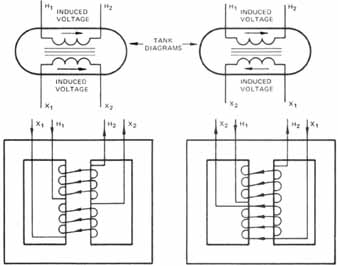
ill. 3: (left, above) Subtractive polarity: Note the induced voltage
ill. 4: (right, above) Additive polarity: Note the induced voltage
ills 3 and 4 illustrate two systems of marking polarity. In conventional usage, polarity refers to the induced voltage vector relationships of the transformer leads as they are brought outside of the tank. The American National Standards Institute has standardized the location of these leads to obtain additive and subtractive polarity conditions. All high-voltage leads brought outside the case are marked H1, H2 and so forth, while the low-voltage leads are marked X1, X2. The H lead is located on the left side when facing the low-voltage leads. Both H1 and X1 are both positive at the same instant of time.
Subtractive Polarity. The tank diagram in ill. 3 shows the relationship of the induced voltages in the primary and secondary windings for the subtractive polarity condition. Transformers connected in this manner have the H and X leads located directly opposite each other. If H1 and X1 are connected together (as shown in ill. 5), the voltage measured between H2 and X2 is less than the primary voltage. The induced voltages opposes the supply voltage and thus causes the secondary induced voltage to be subtracted from the primary voltage.
Additive Polarity. The tank diagram in ill. 4 shows the voltage relationship of the induced voltages for the additive polarity connection. When H1 and X2 are connected, the voltage across H2 and X1 is greater than the primary voltage. The measured voltages add up to the sum of the primary and secondary voltages.
Transformers which are rated up to 200 kVA and have the value of the high-voltage winding equal to 8,660 volts or less will be additive. All other transformers will be subtractive.
Test for Polarity. Transformer coils often must be connected in series or parallel as in ill. 6. For these situations, the polarity of a transformer or any secondary coil can be found by making the connections shown in ill. 5A and B. Connect the adjacent left-hand, high-voltage and low-voltage outlet leads facing the low-voltage side of the transformer. Apply a low-voltage supply to the primary and note the voltage between the adjacent right-hand, high- and low-voltage terminals.
• For subtractive polarity, the voltmeter reading (V) is less than the applied voltage.
The voltage is the difference between the primary and secondary voltages, Ep - Es (ill. 5 A).
• For additive polarity, the voltmeter reading (V) is greater than the applied voltage.
The voltage is the sum of the primary and secondary voltages, Ep + Es (ill. 5B).
If the test shown in ill. 5B indicates additive polarity, the secondary leads inside the tank must be reversed at the bottom of the bushings to obtain a true subtractive polarity. If the transformer requires all additive polarity and the test indicates subtractive, reverse the secondary lead markers so that X2 is located opposite H1. Most transformers are connected in additive polarity.
In all transformers, the H terminals are always the high voltage terminals. The X terminals are always the low voltage terminals. Either the H or X terminals can be designated as the primary or the secondary, depending upon which is the source and which is the load, and if the transformer is used as a step up or step down transformer.

ill. 5 A) Test used to determine subtractive polarity transformer
B) Test used to determine additive polarity transformer. Note use of
jumper.
SINGLE-PHASE TRANSFORMER CONNECTIONS
Series Connection
If a 460/115/230-volt single-phase transformer is to be connected to obtain 460/230 volts, the two secondary coils must be connected in series. The beginning and ending of each coil must be joined, as shown in ill. 6A. The “start” of each coil is identified by an odd-numbered subscript.
Note: If the voltage is zero across X1 — X4 after the series connections are complete, the coils are opposing each other (the polarity of one coil is reversed). To correct this situation, reverse one coil, then reconnect and recheck the polarity.
Parallel Connection
To obtain 460/115 volts, the two secondary coils must be connected in parallel as shown in ill. 6B. The polarity of each coil must be correct before making this connection. The parallel connection of two coils of opposite polarity will result in a short circuit and internal damage to the transformer.
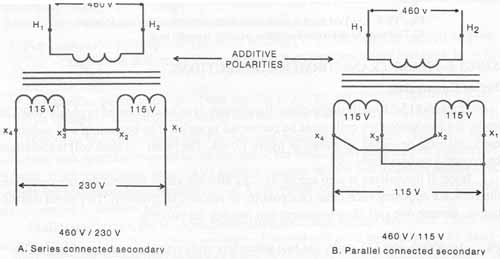
ill. 6 Single-phase transformer connections: A. Series connected secondary;
ADDITIVE POLARITIES; B. Parallel connected secondary
Note: An indirect polarity check can be made by completing the series connection and noting the total voltage. As noted above, zero voltage indicates opposite polarities. Reverse one coil to remedy the condition and then recheck overall polarity. Re-tag leads if necessary.
PARALLEL OPERATION OF SINGLE-PHASE TRANSFORMERS
Single-phase distribution transformers can be connected in parallel only if the voltage and percent impedance ratings of the transformers are identical. This information is found on the nameplates of large size transformers. It is recommended that this rule be followed when making permanent parallel connections of all transformers.
TRANSFORMER PRIMARY TAPS
Taps are nothing more than alternative terminals which can be connected to more closely match the supply, primary voltage. These taps are arranged in increments of 2 1/2 percent or 5 percent of the primary nominal voltage rating of the transformer (ill. 7). This provides a job site adjustment to ensure that the primary of the transformer matches the supply voltage. The secondary will then produce the desired secondary voltage.
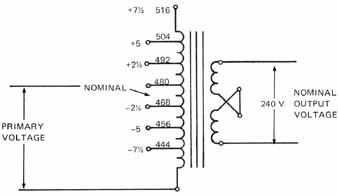
ill. 7 Primary terminal taps
The voltage received from the power utility may be low or high. Since the transformer is a fixed voltage device, the output voltage is always in direct proportion to the input voltage. If the ratio is 2:1 and the supply voltage is 480 volts, the output will be 240 volts. If the primary voltage is 438 volts, the secondary will be only 219 volts.
High and low voltages can have serious effects on different connected loads. There fore, care must be taken to deliver a voltage as close as possible to the desired primary — so that the secondary voltage will match the equipment nameplate voltages. Consistently high and low voltage problems can be solved by connecting the proper primary taps (ill. 8). If the voltage fluctuates consistently, tap changing isn't the solution. A voltage regulating transformer is needed.
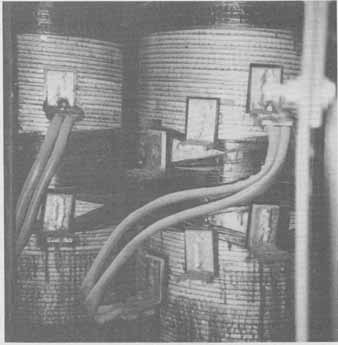
ill. 8: Tap connections used on three phase power transformer.
REGULATION
A slight voltage drop at the secondary terminals from no load to full load is called regulation; these are caused by resistance and reactance drops in the windings. Regulation is expressed as a percentage. Regulation of constant potential transformers is about 1 per cent to 5 percent. Secondary terminals:
% E regulation = ((no load E - full load E) / (full load E)) x 100
Example: The secondary voltage of a transformer rises from 220 to 228 volts when the rated load is removed. What is the regulation of the transformer?
% regulation = ((228 – 220) / 220) x 100 = .036 X 100 3.6%
AUTOTRANSFORMER
Transformers having only one winding are called autotransformers. An auto transformer is a transformer in which a part of the winding is common to both primary and secondary circuits. This is the most efficient type of transformer since a portion of the one winding carries the difference between the primary and secondary currents. ill. 9 shows the current distribution in an autotransformer used in a typical lighting application. The disadvantage of an autotransformer is the fact that the use of only one winding makes it impossible to insulate the low-voltage section from the high-voltage distribution line. If the low-voltage winding opens when stepping down the voltage, the full line voltage appears across the load. According to the National Electrical Code, the use of autotransformers is limited to certain situations, such as where:
a. the system supplied contains an identified grounded conductor which is solidly connected to a similar identified grounded conductor of the system supplying the autotransformer;
b. an induction motor is to be started or controlled (ill. 10);
c. a dimming action is required, as in theater lighting;
d. the autotransformer is to be a part of a ballast for supplying lighting units;
e. to boost or to buck a voltage under certain conditions.
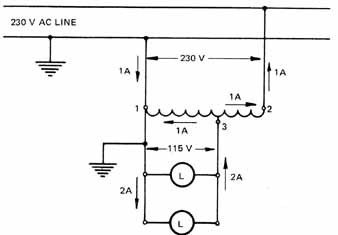
ill. 9: Autotransformer used for lighting.

ill. 10: Autotransformer used for motor starting duty.
DRY AND LIQUID-FILLED TRANSFORMERS
Dry transformers are used extensively for indoor installations. These transformers are cooled and isolated by air and are not encased in heavy tanks, such as those required for liquid-filled transformers. Dry transformers are used for bell ringing circuits, current and potential transformers, welding transformers, and almost all transformers used on portable or small industrial equipment.
Liquid-filled transformers consist of the core and coils immersed in a tank of oil or other insulating liquid. Oil cooling is approximately fifteen times more effective than air cooling. Most distribution transformers designed for outdoor installation are liquid filled.
METHODS OF COOLING
The method selected to cool a transformer must not only maintain a sufficiently low average temperature, but must also prevent an excessive temperature rise in any portion of the transformers. In other words, the cooling medium must prevent the formation of “hot spots.” For this reason, the working parts of the transformer are usually immersed in a high grade of insulating oil. The oil must be free of any moisture so, if necessary, the oil must be filtered to remove moisture. The electrical insulating value of the oil is checked periodically.
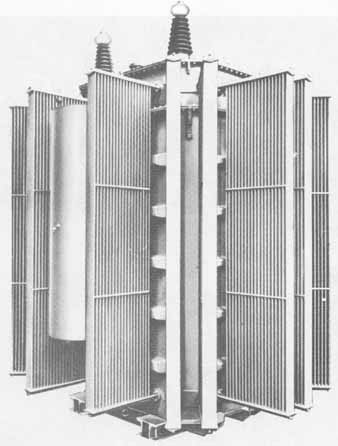
ill. 11: An oil-filled power transformer with radiators.
Duct lines are arranged within the transformer to provide for the free circulation of oil through the core and coils. The warmer and thus lighter oil rises to the top of the steel tank. The transformer core and windings are placed near the bottom of the tank. The cooler and heavier oil settles to the bottom of the tank, This natural circulation provides for better cooling (ill. 11).
Forced Cooling
Several methods of removing heat from a transformer involve forced cooling. Cooling is achieved by using pumps to force the circulation of the oil or liquid, by forcing the circulation of air past the oil filled radiators (ill. 12) or by immersing water-containing coils in the oil. Cold water circulating in the coils removes the heat stored in the oil. Forced air movement by the use of fans is a common practice. Fans are generally con trolled by thermostats (ill. 14). ill. 13 shows internal construction of an oil filled transformer.
APPLICATION
Single-phase transformers are suitable for use in a wide variety of applications as shown by the examples illustrated by figures 15, 16, 17, and 18.
Distribution transformers are usually oil filled and mounted on poles, in vaults, or in manholes.

ill. 12 Cross section of a shell form transformer showing oil-forced
air cooling (FOA or FOAL
FOA with typical temperature rises (Westinghouse Electric Corporation, Power Transformer Division)

ill. 13 Assembly of a large, three-phase, oil-filled station-class
power transformer, such as the one shown in ill. 11 (McGraw-Edison
Company, Power Systems Division)

ill. 14 Transformer temperature indicators (A) Winding temperature
indicator (B) Liquid temperature indicator (Westinghouse
Electric Corporation, Power Transformer Division)
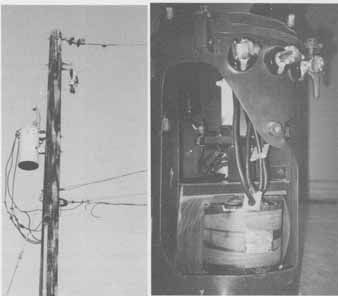
ill. 15 Pole mounted single phase distribution transformer
ill. 16 Cutaway view of distribution transformer
Compensator starters are tapped autotransformers which are used for starting induction motors.
Instrument transformers such as potential and current transformers are made in indoor, outdoor, and portable styles used for metering.
Welding transformers provide a very low voltage to arc welding electrodes. Movable secondaries provide the varying voltage and current characteristics required.
Constant-current transformers are used for series street lighting where the current must be held constant with a varying voltage. The secondary is movable.

ill. 17 Control circuit transformer
ill. 18 Transformer used for electronic equipment
SAFETY PRECAUTIONS
Although there are no moving parts in a transformer, there are some maintenance procedures that must be performed. For a general overhaul of an operating transformer or when an internal inspection is to be made, the transformer must be deenergized. Don't assume either that the transformer is disconnected or rely on someone else to disconnect it, always check the transformer yourself. You must be sure that the fuses are pulled open or out and that the switch or circuit breaker is open on both the primary and secondary sides. After the transformer is disconnected, the windings should be grounded to discharge any capacitive energy stored in the equipment. This step protects you while you are at work also. Grounding is accomplished with a device commonly known as a “short and ground.” This is a flexible cable with clamps on both ends. The ground end is clamped first, then, using a hook stick, the other end is touched to the conductor. Do this with each leg on the primary and secondary sides. The phases are then shorted together and grounded for your protection.
The tank pressure should be relieved. This may be done by bleeding a valve or plug above the oil level. Any gas in the tank must be replaced with fresh air before a person enters the tank. The absence of oxygen in a tank will cause asphyxiation quickly and without warning. A second person should be on duty outside the transformer as a safety precaution whenever someone must enter the transformer. Be sure to follow OSHA rules on hazardous entry and restricted work space. All tools should have safety cords attached with the other end tightly secured. All pockets in clothing should be emptied. Nothing must be allowed to fall into the tank. Great care must be exercised to prevent contacting or coming close to the electrical conductors and other live parts of the transformer unless it's known that the transformer has been deenergized. The tank and cooling radiators shouldn't be touched until it's determined that they are adequately grounded (for both new and old installations).
SUMMARY
Single-phase transformers are used in a variety of applications. In order to connect them correctly, the electrician must know how the ac polarities are established at the transformer leads. Because the internal windings of the transformer are often not accessible, polarity checks must be made on the external leads. The transformer leads are marked according to the standards for additive or subtractive polarity. If the lead markings are not apparent or the voltages expected are not obtained, then the polarity must be tested. If the lead markings are known, the transformer coils may be connected in series or parallel to yield the desired voltage. Auto-transformer connections or tap-changing transformers may be used to bring the voltage within the desired range. Much of the transformers ability to operate satisfactorily depends on the ability to dissipate the heat produced in the windings. Many methods are used to dissipate this heat and keep the transformer from overheating and being destroyed.
QUIZ
Select the correct answers for each of the following statements.
1. Double-wound transformers contain a minimum of:
a. one main winding.
b. one main winding with two coils.
c. a primary and a secondary winding.
d. a primary and a double-wound secondary.
2. A transformer has subtractive polarity when the:
a. two primary coil voltages oppose each other.
b. two secondary coils have opposite polarities.
c. X1 lead is opposite the H1 lead.
d. X2 lead is opposite the H1 lead.
3. A transformer has additive polarity when the
a. two primary coils are in series.
b. two secondary coils have aiding polarities.
c. X1 lead is opposite the H1 lead.
d. X2 lead is opposite the H1 lead.
4. Polarity should be tested before
a. energizing a transformer.
b. checking the ratio.
c. connecting the coils in series or parallel.
d. connecting the load to the secondary.
5. A 440/110/220-volt step-down transformer is connected for 440/220 V. Preliminary tests show that each secondary coil has 110 volts but the voltage across X1 - X4 is zero. The probable trouble is that:
a. the voltages in the coils are equal and opposing.
b. their ratings are equal.
c. the load will divide in proportion to the capacities.
d. the voltage drops at full load will be proportional to their respective loads.
6. The autotransformer may be used as a:
a. power transformer.
b. potential transformer.
c. current transformer.
d. compensator motor starter.
7. Insulation of transformers may be classed in two groups:
a. double-wound and autotransformers.
b. dry and oil-filled types.
c. core and shell types.
d. core and cross types.
8. Regarding cooling, transformers may be
a. air- and oil-cooled.
b. outdoor- and indoor-cooled.
c. self- and forced-cooled.
d. dry- and liquid-cooled.
9. Single-phase, double-wound transformers must be used for
a. distribution and compensator starters.
b. instrument and welding transformers.
c. welding and dimming in theater lighting.
d. constant current and reduced voltage motor starters.
10. For low voltage, the secondary of a single-phase transformer is connected:
a. X1 and X3 to load, X3 and X2 together.
b. X1 to X3 to load, X2 to X4 to load.
c. H1 to H4 to load, H3 to H2
d. H1 to H2, X1 to X2.
11. A transformer in which part of the secondary is part of the primary is:
a. a series and parallel connection.
b. a double-wound transformer.
c. an autotransformer.
d. an isolating transformer.
12. Parallel operation of single-phase transformers call be accomplished when the:
a. voltage and percentage impedance ratings are identical.
b. voltage and current ratings are equal.
c. cooling methods are identical.
d. primary and secondary voltage ratings are equal.
13. Primary taps are designed to:
a. raise the voltage of the secondary.
b. drain the oil.
c. lower the voltage of the secondary.
d. raise or lower the voltage of the secondary.
14. A slight voltage drop at the secondary terminals from no load to full load is called:
a. reactance. c. percentage.
b. regulation. d. taps.
15. When working in a large transformer, the electrician should:
a. ventilate it first.
b. short and ground all windings.
c. secure all tools and empty pockets.
d. all of these.
16. When preparing to work on an oil-filled transformer, one should first:
a. bleed the tank pressure.
b. disconnect the supply voltage and load.
c. disconnect all other connections.
d. check the disconnect switches yourself.